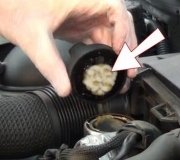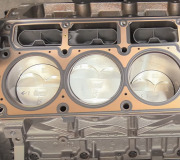We replaced the intake manifold gasket after the student came in from his prom weekend claiming the car had overheated several times, and he had to add water and such to the car. Having done my research and fair share of repairs on the 3100's, I knew the intake gasket issue, but the student stated he parked the car every time the guage got to the red and waited. (He probably lied, but not for me to judge.)
I digress. We took the plenum and all the goodies off the top end, removed the valve covers and lower intake, and sure as a bear pooping in the woods, the intake gasket was split near the thermostat near the #6 cylinder, but in the water jacket hole.
Having decided this was the primary leak, we went ahead and swapped out the gasket, removed all the pushrods and such, completely reinstalled, retorqued all bolts and such to spec, have it up and running, then almost 15 minuted into bleeding coolant system and checking for leaks, car developed a misfire (heavy), and I shut it down. Pulled the dipstick (on instinct), and again, plenty of dexcool in the oil.
So. My question to the pro's, in my experience, we assembled everything properly, and the intake was true with a straight edge. Do we presume now, the head is faulty and it is now a headgasket issue? The student has NO money for a machine shop, let alone another intake gasket set AND head gaskets. If this is the case, Im willing to bet my meager salary he will junk the car. But I would like to offer him a sunny side if at all possible, if we may have made an error somewhere or something simple?
The motor had the oil changed as well while the intake gasket was changed, and the rockers were adjusted properly according to GM, and felpro gaskets installed on both intakes, as well as injectors and all other gaskets from a felpro intake set.
Any way aside from a leak-down test (i dont have that tool just yet.), Or a pressure test (car does not have rad cap) to determine source?
Thanks all!
SPONSORED LINKS
Friday, May 28th, 2010 AT 3:15 PM




